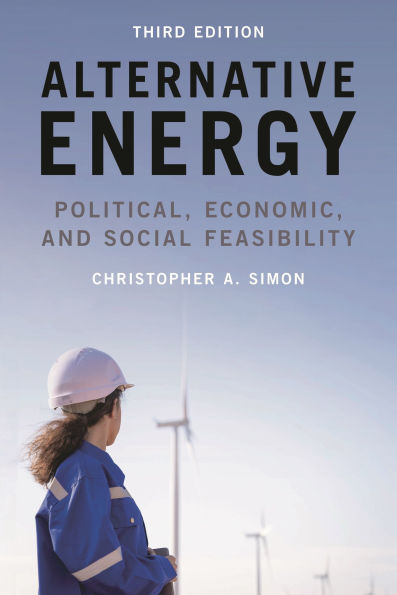Table of Contents
List of IllustrationsPreface
About the Author
1Why Alternative Energy and Fuels?
Climate Change and Carbon
Energy and Water
Carbon-Based Fuels: Current and Future Availability
Common Fossil Energy Sources: U.S. Supply and Use
Culture Shifts and the Rise of Green Politics
Green Politics and Environmental Public Interest Groups
New Environmental Paradigm and Alternative Energy
Institutional Change and Influence
Global Demands and Conflict
Chapter Summary
References
Executive Order
Court Cases
2Studying Public Policy and Alternative Energy/Fuels
Roles for Public Policy in Alternative Energy/Fuel Development
Policy Process
Agenda Setting
Policy Formation
Policy Implementation
Policy Evaluation
Policy Termination/Change
Policy Types
Bottom-Up Policy Making/Top-Down Policy Making
Collaborative Policy Making
Federalism and Energy Policy
Policy Frameworks/Models
Institutional Analysis and Development (IAD)
Multiple Streams (MS)
Advocacy Coalition Framework (ACF)
Punctuated Equilibrium (PE)
Policy Diffusion
Narrative Policy Framework (NPF)
Intergovernmentalism
Native Americans, Tribal Lands, and Renewable Energy
Chapter Summary
References
Statute
Case Law
Regulation
3Alternative Energy/Fuels as a Public Policy Innovation
Defining Alternative Energy and Alternative Fuels
What Are Alternative Fuels?
Policy Innovation and Alternative Energy
The Waves of Policy Innovation
Oil Shock I/Pre-PURPA 1970s (1973–1978)
Secondary Oil Shock Period (1979–1982)
Resurgence of Cheap(er) Petroleum and Growth of Deregulation (1983–1999)
Bush I: EPAct Reauthorization (1992)
Clinton and Post-EPAct 1992 Reauthorization (1992–2005)
Bush II: EPAct 2005 Reauthorization, ESIA 2007, FERC Order Innovations, and Electricity Markets (2001–2009)
Obama: ARRA 2009, Coal Rules, and Paris Agreement (2009–2017)
Trump: Resurgence of Coal, Reversal of Climate Policy, Energy Act of 2020 (2017–2021)
Biden: Re-Engagement of Climate Policy, COP26, Infrastructure Renewal, Funding of Energy Act of 2020 (2021-present)
Chapter Summary
References
Court Cases
4Solar Energy
What Is Solar Energy? How Does It Work?
Silicon-Based Photovoltaic Cells
Technical Feasibility of Solar Photovoltaics
Technical Feasibility of Solar Thermal
Economics of Solar Power
Current Solar PV Energy Economic Infrastructure and Levelized Cost of Electricity
Economics of Solar Thermal—Concentrating Solar Power
Economic Development Impacts
Case Study—Heritage Plaza Parking Lot Improvements Project: Solar PV Carport Installation, Agua Caliente Indian Reservation, Agua Caliente Band of Cahuilla Indians
Federal Solar Energy Technologies Program
Major Federal Solar Incentives
Commercial Incentives
Personal Tax Incentives for Solar PV and Solar Thermal
State and Local Efforts
California
Honolulu, Hawai’i
Chapter Summary
References
5Wind Energy
What Is Wind Power? How Does It Work?
Technical Feasibility of Wind Power Systems
Economic Feasibility of Wind Power Systems
Political and Social Feasibility of Wind Energy
Chapter Summary
References
6Geothermal Energy
What Is Geothermal Energy? How Does It Work?
Case Study—California Job Growth and Geothermal Development
Safety, Environmental Damage, and Emission-Related Issues: Geothermal Energy
Technical Feasibility of Geothermal Energy
Heat Pumps
Other Forms of Direct Use
Flash Steam Power
Binary Systems
Economics of Geothermal Energy
Federal Geothermal Energy Programming
State and Local Efforts
Chapter Summary
References
7New Century Fuels and Their Uses
Fuel as a Concept
Natural Gas
Other Alternative Fuels
Clean Diesel
Biodiesel
Ethanol
The Hydrogen Initiative
Hydrogen and Fuel Cells
Technical Feasibility Issues
Economic Feasibility Issues
Other Types of Fuel Cells Currently in Use and/or Under Development
Alkaline Fuel Cells (AFC)
Direct Methanol Fuel Cells (DMFC)
Molten Carbonate Fuel Cells (MCFC)
Phosphoric Acid Fuel Cells (PAFC)
Solid Oxide Fuel Cells (SOFC)
Applications for Next-Generation Alternative Fuels, Fuel Cells
Transportation
Military Applications
Residential
Commercial
Chapter Summary
References
8 Energy Storage Technology and the Automotive Industry
Introduction
The Automobile
Battery Electric Vehicles (BEVs)
Political Feasibility
BEVs and Consumer Behavior Issues
Consumer Choice
Chapter Summary
References
9Reforming the Power Grid
Introduction
The Power Grid
RM21-17-000 Building the Future Through Electric Regional Transmission Planning and Cost Allocation and Generator Interconnection
Who Pays for the Power Grid?
Transmission Grid, Public and Native American Lands
Chapter Summary
References
Court Cases
Public Laws
10 Artificial Intelligence and Energy
Artificial Intelligence: Origins and Meaning
AI, Alternative Energy, and the Power Grid
Narrow AI, Strong AI, and the Future
The Economics of AI
Economics and AI
Smart Grid, AI, and Public Policy
Chapter Summary
References
Legal Sources
11Historical Precedents: Alternative Energy/Fuels and Legitimacy Issues
Risk and Culture: Alternative Energy and Hidden Costs
Hydroelectric Dams
Nuclear Energy
The Rebirth of Nuclear Energy?
Chapter Summary
References
12Conceptualizing Alternative Energy Policy and Future Directions
Future Directions
The Movement of Public Opinion
Concluding Remarks
References
Index



